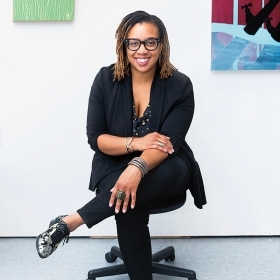Sharp angles. Dark windows. Blank concrete. The entrance to the Davis Museum is minimalist to a fault. The challenge: to make the courtyard and its environs more lively and welcoming to students, faculty, staff, and visitors alike.
“We wanted something that activates the space, so that it becomes an entryway, rather than a barrier,” says Lisa Fischman, Ruth Gordon Shapiro ’37 Director of the museum. She initiated a project to commission one artist each year to create a mural for the windows.
David Teng Olsen, associate professor of art at Wellesley, was tapped for the first installation. The commission enabled him to reflect on his career at the College as well as on his relationship to the museum’s collection. “The mural is based on the shapes, colors, and imagery that appealed to me,” he says. “It also shows the influence of all the artists I’ve met, and the artists I’ve collaborated with, over my 11 years here.”
Teng Olsen was inspired by the Belgian-born, Mexico-based artist Francis Alÿs and his 2011 multimedia installation for the Davis, as well as by a 2015 exhibition of sculpture by Iranian artist Parviz Tanavoli, both of whom are experts at moving between cultures. “They’ve taken their lives and personal experiences and spent their careers making art about [them],” he says.
Teng Olsen studied bioengineering before switching to art as an undergraduate. He has painted large-scale public murals, created 3-D animation and scientific illustrations, and he’s also worked in stained glass.
He took an improvisational approach to the composition. “I think about how the world seems chaotic, it seems to improvise all the time. [But] if you think about the big picture, physics and science and nature manage to pull things together.”
His Davis mural vibrates with geometric shapes, bringing what Fischman calls “a sense of joy and exuberance” to the courtyard. Teng Olsen’s windows pull viewers in to look more closely. Then they discover that his strict geometry is animated by abstract and playful elements that have a hand-drawn quality.
The designs were created on a computer and then reproduced on vinyl sheets in a new process that allows for the layering of colors in the printing stage, says Teng Olsen. This eliminates the time-consuming steps of cutting out each shape in vinyl before layering them.
The mural—presented with generous support from Wellesley’s Friends of Art—will stay in place for a year. The next artist to transform the windows will be Daniela Rivera, associate professor of art.








We ask that those who engage in Wellesley magazine's online community act with honesty, integrity, and respect. (Remember the honor code, alums?) We reserve the right to remove comments by impersonators or comments that are not civil and relevant to the subject at hand. By posting here, you are permitting Wellesley magazine to edit and republish your comment in all media. Please remember that all posts are public.